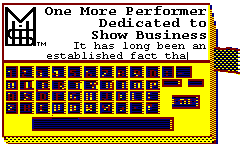 One More Performer
Dedicated to
One More Performer
Dedicated to
Show Business
Cats' spectacular lighting won a 1983 Tony for lighting designer David Hersey, but it would have required six electricians (lighting stage hands) to operate if it were not for the Kleigel. Cats Company's master electrician Stitch Cantrell, responsible for programing Hersey's lighting design into the Kleigel Performer, and assistant electrician Paul Case are the only light persons required with the use of the computer.
Receiving cues from the stage manager and in constant contact with the stage through video monitors and headphones, Cantrell manages the computer's control board, and Case takes care of the special manual lighting that requires human control. Instructions for the computer are stored on cassette tapes for each act.
Cats Company rents the Kleigel from Four-Star Electric out of New York. Cantrell estimates the actual cost of the computer itself at $36,000 and says, by the time the equipment is added on (dimmers, etc.), the cost works its way into six figures.
Can a Chicago musical support such expensive equipment --even on a rental basis? According to Lewis Lazare in the August 1985 Stagebill, in the three-month period between March 23 and June 28, 1985, the Chicago production of Cats took in 6.9 million dollars,
Theatre is, at times, big business; is the computer there to stay? Cantrell believes the computer has its place in theatre, but "the process will never be totally computerized."
As Cantrell points out: "Actors never do exactly the same thing twice. I remember a show I did at Walt Disney World that had everything completely computer controlled. The first night was perfect, but the next night the lights fell out of sync with the actors, and it was a disaster."
He continues,"Once they even tried having actors wear little sensors so computerized spotlights could follow them automatically. They didn't have much success with that, either."
Case concurs, noting a night when Cats was in Washington, D.C., and the computer light board failed just before a performance. "The management announced technical difficulties," Case explains, "and Stitch and I were forced to improvise the best we could. We did pretty well. The next day people were calling the theater asking what was supposed to be wrong. It looked fine to them!"
Nonetheless, theaters across the country are turning toward computers. And computers like the Kleigel Performer that can handle up to 512 different stage lights with split-second timing are part of the reason why.
 Go to next:
Go to next:("Batavia Firm Rides on CoCo's Coattails")
 Next next:
Next next:("New Computer Service Profits Nonprofit Organizations")
 Go to Computer Experience resume pages
Go to Computer Experience resume pages Inquire about "Think Mills" computer-related writing, training, and services
Inquire about "Think Mills" computer-related writing, training, and services Choose another business/news/professions sample
Choose another business/news/professions sample Go/return to overall Table of Contents
Go/return to overall Table of Contents